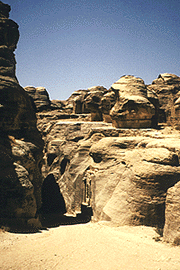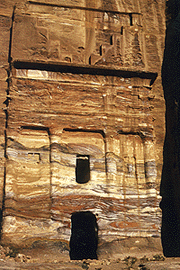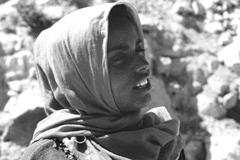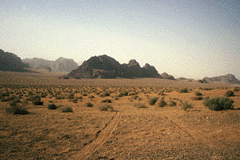

To me Jordan is a wonderful place for a vacation; people are friendly, there is rarely any hassle, and I enjoyed my time there very much. The mountains and desert of Jordan radiate a wild and desolate beauty all of their own. It is these sun-baked wadis and giant granite crags that 'Lawrence of Arabia' describes in his 'Seven Pillars of wisdom'.
And then there is the story of "The Hidden City", which was the name that was written in several travel-stories. Scientists and travellers went looking for it but couldn't find her. People started doubting if Petra ever existed.

Was it a history or a myth?
Only the local Bedouin people knew that the city really exists because they lived within the caves. But nobody asked them and they didn't tell. Almost two thousand years, Petra wasn't more then just a mystereous sound, a name in dusty documents.
Yet in the previous century, the Swiss traveller and orientalist, Johann Ludwig Burckhardt, found the long lost city. Converted to the Islam, disguised like an Arab, he menaged to win confidence of the Bedouins. What he saw, as the first stranger in about 2000 years, must have made him happy for the rest of his life.

I went to Jordan in 1995 and I would recommend you to visit the country as soon as possible. You can find reports everywhere about the efforts of the government to develop tourism and make it the main source of income for the Jordanian economy. In december 1996, I even read an article that the area around Petra has been turned into a cluster of hotels. There were a handful of hotels when I visited Petra in September 1995.
Our airplane landed in AMMAN, capitol of Jordan. Visa procedures really don't make a whole lot of sense at all. You can even buy a visa at the airport. I joined a group of English and Irish travellers and we moved on together for about eleven days. We didn't spend any time in Amman itself.
We visited the Desert Castle in AZRAQ, where Lawrence of Arabia had his strategic headquarters, the beautiful bathhouse of Amra and the famous Roman town of JERASH. After a swim in the Dead Sea we drove south to Mt Nebo where we had a view of the Promised Land seen by Moses. Then we descend into the gigantic ravine of Wadi Mujib before climbing to the rocky pinnale of EL KERAK. At last we arrive to the rock-hewn city of PETRA, the forgotten city, found by the explorer Burckhardt in 1812. Petra is mentoined in every encyclopaedia but it doesn't belong to the seven wonders of the world. What a great pity. You might consider calling it the eight wonder!
From the official entrance to the site, a dusty trail leads gently downwards along the Wadi Musa - The Valley of Moses. Wadi means dry riverbed. Situated in small rock outcrops to the left and right of the path are some small Nabataean tombs, carved into the dry rock. Beyond these, walls of sandstone rise steeply on the left, and a narrow cleft reveals the entrance to the Siq, the principal route into Petra itself.
 The Nabataeans were expert hydraulic engineers. The walls of the Siq are lined with channels (originally fitted with chamfered clay pipes of efficient design) to carry drinking water to the city, while a dam to the right of the entrance diverted an adjoining stream through a tunnel to prevent it flooding the Siq.
The Nabataeans were expert hydraulic engineers. The walls of the Siq are lined with channels (originally fitted with chamfered clay pipes of efficient design) to carry drinking water to the city, while a dam to the right of the entrance diverted an adjoining stream through a tunnel to prevent it flooding the Siq.
Once inside, the Siq narrows to little more than five metres in width, while the walls tower up hundreds of metres on either side. The floor, originally paved, is now largely covered with soft sand, although evidence of Nabataean construction can still be seen in some places.
The Siq twists and turns, the high walls all but shutting out the early morning sunlight, until abruptly, through a cleft in the rock, the first glimpse of the city of Petra can be seen. Carved out of pale reddish sandstone, ornate pillars supporting a portico surmounted by a central urn and two flanking blocks, jut out from the cliff face ahead. This is the Khazneh, the rock-cut Treasury, the place where film-maker Steven Spielberg shot the finale of his film 'Indiana Jones and the Last Crusade'.
 A little further on, on the left is the giant semicircle of the amphitheatre, which had seats for eight thousand people. Behind it, the rock wall is pitted with tombs. Close to the theatre, a flight of steps marks the start of the climb towards the High Place of Sacrifice, while continuing towards the right, the wadi widens out. Ahead lies the centre of the city, while following the cliff face further to the right takes you to three large structures, known as the Royal Tombs. They have been carved into the rock face, which is known as the King's Wall.
A little further on, on the left is the giant semicircle of the amphitheatre, which had seats for eight thousand people. Behind it, the rock wall is pitted with tombs. Close to the theatre, a flight of steps marks the start of the climb towards the High Place of Sacrifice, while continuing towards the right, the wadi widens out. Ahead lies the centre of the city, while following the cliff face further to the right takes you to three large structures, known as the Royal Tombs. They have been carved into the rock face, which is known as the King's Wall.
El-Deir, the Monastery resembles the Khazneh, but is larger, cruder and more eroded. The great doorway is around eight metres tall, and the facade as a whole is approximately fifty metres wide by forty-five tall. The whole structure, like the Khazneh, has been carved out of the rock face, and the flanking walls reveal clearly how deep the builders cut into the cliff to create it.
A young girl with their goats is dwarfed by the craggy rocks that surround the ancient city of Petra. Many of the Bedu living in Petra keep their sheep and goats in caves that wee once the tombs of the Nabataeans, the founders of this ancient city. Nowadays, the Bedu who once had a tent pitched in Petra, live in the government-sponsored village nearby.
The Rose Red city, half as old as time, is carved from a mountain of multicoloured sandstone and is one of the world's most amazing archaeological wonders. Its rock-cut Treasury - Khasneh al Faroen - once stored the 'Queen of Sheba's' gifts of Solomon. This is one of the most beautiful and most impressive places on earth where I've been. Nature has left behind some remarkable artworks throughout the centuries, which make it more than worth while to make a trip to Petra!


Only one hour drive from Petra to the east, we reach majestic Wadi Rum. We trek deep into the sandy desert by camel, riding beneath the sheer cliffs of a vast, silent landscape of ancient riverbeds and pastel-coloured stretches of sandy desert, suddenly shattered by towering sandstone mountains and sheer, shimmering cliff-faces. We move on sitting forward of the hump of a camel, our legs crossed around the front pommel of the saddle. The camels carry handsome camel bags decorated with long, braided tassels. We are dwarfed by the mountains. In the desert, without familiar objects such as trees to act as a guide, it is often difficult to get a sense of scale and to appreciate the vastness of the terrain.
This is Lawrence of Arabia's country, the awesome yet bewitching place of shimmering sands described in his Revolt in the Desert. Some of the most beautiful scenes from the world-famous movie 'Lawrence of Arabia' were shot in Wadi Rum by film-maker David Lean. It once was the military base of the British bedouin Thomas Edward Lawrence, who worked for the secret service of the British army in the Middle East during World War I.
Wadi Rum in southern of Jordan is a spectacular area of high sandstone mountains separated by enormous sandy wadis. We spend two nights in a Bedu encampment - a Howietat tent battened down against the strong winds - under a desert sky crowded with stars. All around us stretch the solitary vertical cliffs of the wadi, burned crimson in the evening sunlight. A full moon rises over the desert, where the air is often so clear that it is possible to read a large print book by moonlight and to see the night-time landscape with total clarity ...
This is a non-profit web page. All the establishments mentioned in this travelogue are places I've been to and which I would like to recommend to people who like to travel around in Jordan.
I would like to thank my dear friend, Marit.
Travelogue and photographs by Joël Neelen © September 1995. All Rights Reserved.
| Algeria, Tassili n'Ajjer | Greece, the Dodecanese | Greece, the Cyclades | Morocco, the Massif Sirwa | Morocco, the High Atlas |
| Cuba | India | Egypt | Yemen | Jordan | Myanmar | Peru | Turkey | Barcelona |